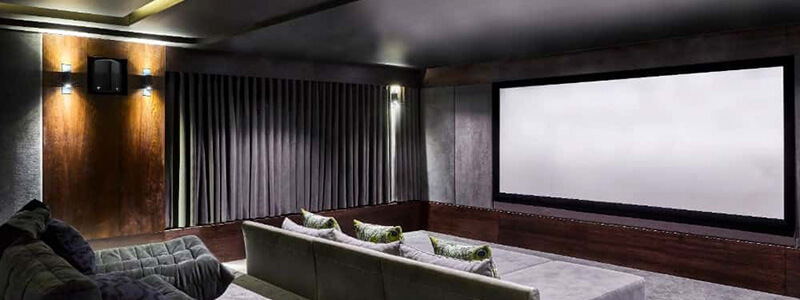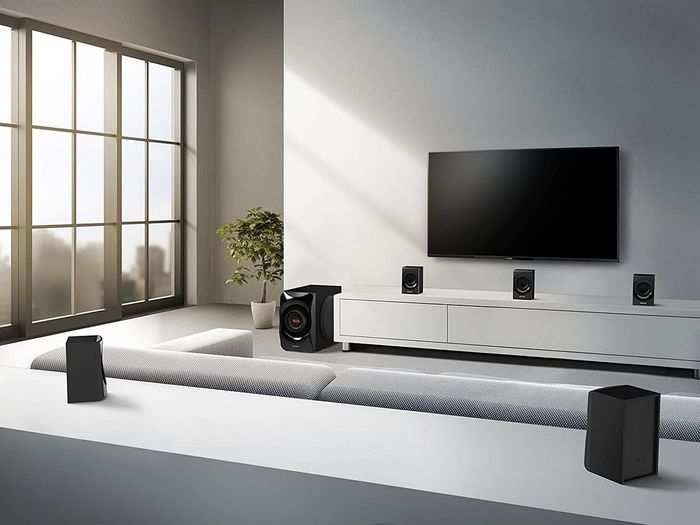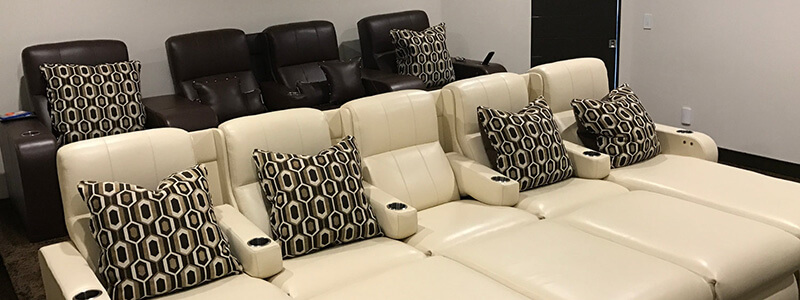Thanks to technology becoming more and more affordable, many Australian families are now enjoying the theatre experience in the comfort of their own homes.
Building or remodelling your home to include a dedicated home theatre is an exciting task that is sure to bring hours of entertainment to your family and friends with style. But there’s more to it than meets the eye!
We at Sarros Electrical have helped wire up and install many home movie rooms! Regardless if you’re converting an existing room into a home theatre set-up or if you’re creating a brand new setup, we wanted to share with you 7 important things to think about that makes your home theatre a great home theatre. They are:
- Determine the ideal size of your home theatre.
- Find the ideal location of your home theatre in the home.
- Choose the best screen and screen size.
- Lighting is important.
- Ensure good sound.
- Keep the sound where it belongs!
- The ideal seating location.

Tip 1: When it Comes to Home Theatres, Size Matters!
This sounds obvious, but think carefully about exactly what you’re willing to put into your home theatre project, and what you want to get out of your home cinema:
- How big is your budget?
- How many people do you want to have in the room at any given time?
- How would you like your theatre seating to be arranged?
- What size screen are you planning to put in?
To keep that cinema feel and to avoid becoming claustrophobic, we recommend using a room at least 4.6m wide and 6m long, but the standard room size for home theatres is around 9 meters by 9 meters. This allows for a good all-around screen-watching experience for the whole family and then some!
Of course, constraints such as a budget and the area available are factors to consider, but going smaller than 4.6 by 6 meters will probably compromise on viewing quality and the overall feel of the room.

Tip 2: Location, Location, Location!
We suggest keeping the room away from high traffic areas of the house, and for good reason. As great as soundproofing is, nothing ruins the atmosphere of a movie quite like hearing your dishwasher finishing its wash cycle during the silent build up to a scary moment! Plus, hearing explosions and gunshots coming from the cinema probably won’t be helpful to anyone trying to study or sleep in the next room! Planning ahead carefully will save yourself future headaches!
Home theatres are best kept as a dedicated space! Sharing this space with other activities, such as a playroom, or having an open plan, such as sharing space with the kitchen, will detract from the movie experience. Sharing the space also makes it difficult to control lighting and sound when members of the family are engaged in different activities. Trust me, that kettle will start boiling just when you need to hear what was whispered in the movie!

Tip 3: Projector? Screen? How big can I go?
Going back 10 years, projectors were without a doubt the way to go to watch movies in big screen format, but as technology has improved, the situation is no longer so cut and dry.
When deciding between a projector or a screen weigh up some of the following:
If you’re thinking of choosing a TV for your cinema room, consider:
- A modern TV, especially OLED and 4K, will always provide higher resolution.
- Slimline TVs are easier to mount on a wall.
- TV models go down in price within their first year of production yet their quality remains.
- TVs do get outdated comparatively quickly as new models are always coming out.
- TVs can be viewed comfortably in a room with a high degree of ambient light (i.e a room with many or large windows)
If you’re thinking of choosing a projector for your cinema room, consider:
- If you’re looking for a screen above 100 inches, choose a projector! This is your best bet at least the next few years.
- Drop-down projector screens can be rolled up and hidden when not in use, so a TV doesn’t need to dominate the room.
- Ambient light levels affect the visuals of a projector far more than compared to a standard TV.
- Larger projectors can generate significant amounts of heat and noise.
Regarding how big you can go, there are a few things to keep in mind:
Firstly, what do you primarily plan on watching? Are you planning on having the boys over often to watch the footy or are you planning on binge watching your favourite series with your girlfriends? If so, we’d recommend going for a screen that offers a 16:9 Ratio as that’s what most TV programs use. Though, if you do plan on using it to watch movies occasionally, you’ll have to deal with black bars on the top and bottom of the screen.
If you’re a movie fan that enjoys sitting down on the weekend, shovelling down popcorn, then the Cinemascope 2.35:1 Ratio is for you because that’s what almost all movies are filmed using these days. However, when watching TV or the News you’ll have to accept having the black bars on the sides.
If you’re not a fan of black bars on either side of the screen, why not select the best of both using a multi-format screen, this will mask the parts of the screen that aren’t configured to your chosen ratio and allow you to display the media in without any distractions.
And finally, it comes down to how big your wall is, how physically big a Screen you can fit, but let’s be honest…
“I wish a got a smaller screen”
– said no one ever

Tip 4: Think Lights Before the ‘Camera… Action!’
Why do you need good lighting? Isn’t that what the screen is for? Well yes and no… when you step foot into a cinema the presence of graduated light, although quite low, is presented in such a way to highlight certain features of the room and conjure up that cinema feeling.
To mimic this in your own home and really maximize that comfy cinema feel we recommend installing light controls that allow graduation within the cinema space. When combined with Alvey LEDs that glow gently from behind the viewer, the effect really contributes to that timeless theatre feeling.
Ambient light also needs to be minimised or blocked, such as light from windows or from underneath and around the door. Think about where ambient light is coming from. Will it reflect off the screen or detract from watching the movie? Over-sized light-blocking curtains or shades can help if your room has windows.
Ambient light can also come from that AV equipment that’s often placed under the TV. AV equipment can be placed behind a cabinet door (as long is it’s well ventilated) or to the side to minimise this.

Understandably choosing the right lighting, the correct placement and even the right brightness can be a somewhat daunting task, why not let an expert from here at Sarros help you out? We know LED lighting and ambient lighting inside and out.

Tip 5: Make the Acoustics Awesome!
At the end of the day when it comes to home cinemas, we only really care about two things; Clearly seeing the screen and what’s happening, and hearing it!
For the uninitiated, audio set up is confusing, but let’s break it down. Most cinemas use 5.1 surround sound, maybe you’ve heard this term before. The numbers actually refer to the layout of the speakers.
The first number, “five”, refers to the satellite speakers around the outer edges of the room, three are located near the screen at the front of the room and two are located at the back.
The “one” is in reference to the subwoofers, which provides the bass – that low and powerful frequency that you can actually “feel” – you know, it’s that rumbling through your body during a car chase or during an explosion or earthquake in a movie.
Many different layouts exist such as a 6.1,7.1, or 7.2, but if you’re on a tight budget it’s best to keep things simple and go for a good quality 5.1 arrangement as opposed to an average quality 7.1 layout.
You’ll need a central hub that will house your receiver and other AV equipment. So don’t forget to plan this out in advance or seek advice from an expert!
These days, sound bars do a great job too, but the difference between TV and a theatre is having true surround sound.


Tip 6: …but Keep the Acoustics where they Belong!
As we mentioned before, hearing someone sneeze while chopping onions right before the star couple says their “I do’s” can be a little off-putting, so how do we mitigate this? Soundproofing! Soundproofing also ensures crisp sounds that don’t echo around the room – allowing for a better home theatre experience.
When it comes to building a well-insulated cinema room, use materials that absorb sound. Anything that reflects sound or transmits it is going to make for a poor soundproofing material and a noisy theatre room.
Firstly, we recommend a second layer of insulation inside the wall to mop up excess sound. Secondly, we recommend using a thickly carpeted floor, especially if your cinema room is located on the second floor.
Thirdly, and most importantly, use acoustic boards and carpet tiles on the walls to do most of the heavy lifting in terms of sound absorption. When combined with upholstered chairs and thick curtains, your movie will sound crystal clear without the interruption of outside sound that may leak in.
Want to know a little DIY hack? Egg cartons make for great sound dampeners!


Tip 7: Where Would You Like to Sit?
When it comes to seating, we all like to think that sitting as close to the TV as possible is the best option, however, anyone that’s ever sat at the bottom row in a Cinema knows this is a recipe for neck pain and regret.
So what is the best way to arrange your seating plan so that everyone can enjoy the movie – pain-free?
Here are a couple of factors to keep in mind thanks to the organization known as THX, the world leader in Motion Picture Technology:
Vertical Viewing Angle
Studies by THX have shown that the average viewer should not have to look more than 15° upwards or downwards to avoid discomfort. It sounds pedantic, but having your eyes dance up and down constantly for over 2 hours can be exhausting and cause headaches.

Additionally, the average Aussie eye level when seated is anywhere between 105cm – 120cm. According to THX’s general rules of thumb, the bottom third of the screen should be somewhere in that range. Remember to make allowance if your home theatre has raised levels of seating.

This means that it’s best to have a screen size proportional to the viewing distance. The shorter the distance you sit from the screen, the smaller the ideal screen size (we’ll discuss this shortly).
And just because a screen has been mounted, doesn’t mean it can’t be moved again, have a play around with it, watch a few movies and see if you feel comfortable. If you’re not comfortable, adjust it up or down until it’s just right.
Horizontal Viewing Angle
To find the best horizontal viewing angle, we’re going to need to do some simple calculations. But don’t panic, they’re simple and we’ll walk you through them to help you find the best way to set up your theatre space.
According to the THX standard, for every inch of diagonal screen size (2.5cm), one must sit approximately 1.34 inches (3.4cm) away.
For example, if you plan on using a 140-inch Projector as your main attraction, you need to first multiply that by 1.34, which is 187.6 inches to find your best seating distance. 187.6 inches converts to 476.5 centimetres (thanks Google).
But what if your room is only 4.5m deep? You have 2 options, cut a hole in the wall to give you more space… or more realistically buy a smaller screen.
An alternative and easy way to determine the best screen size for TVs, according to Sony, is to sit at a distance 1.5 times the vertical height of a 4K TV, and at a distance of 3 times the vertical height of a Full HD TV.
In Short, you can find the best place to sit from your screen by:
- Finding the diagonal screen size
- Multiply by 1.34 to find the minimum recommended sitting distance
- Multiply those pesky inches by 2.54 to convert into centimetres

…and the Final Tip: Enjoy!
DIY home cinema installations can save you some money, but you may arrive at a point where you’re needing a little assistance, especially when it comes to a professional finish with the right electrical components such as smart lighting and cable placement. Always use a trusted and licenced electrician to install electrical wiring or cables. Sarros Electrical is Perth’s go to electrician when it comes to wiring up the best home theatre systems! We also love sharing our experience to ensure your project has the best results overall!
With these points in mind, we’re confident your home theatre room will be ace! And we hope you, your family and friends have hours of fun!


